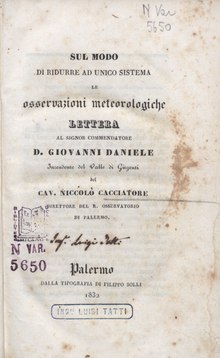Niccolò Cacciatore
Niccolò Cacciatore (born January 26, 1770 in Casteltermini , † January 28, 1841 in Palermo ) was an Italian astronomer .
When Cacciatore studied mathematics and physics in Palermo , he made the acquaintance of Giuseppe Piazzi and in 1798 became an assistant at the observatory in Palermo . Two years later he was permanently employed there, a year before Piazzi discovered the dwarf planet Ceres . In 1812 he married Emmanuela Martini, with whom he later had five children.
Cacciatore helped Piazzi to create the second edition of the Palermo Star Catalog (1814), for which he had worked in a leading position since 1807. In this catalog he secretly immortalized his name by naming the two brightest stars in the dolphin constellation . They are still called Sualocin and Rotanev today , which when read backwards results in “Nicolaus Venator”, the Latinized form of Niccolò Cacciatore.
Cacciatore also published works on the comets of 1807 and 1819. In 1817 he followed Piazzi as director of the Palermo observatory. During the Sicilian Revolution of 1820, the observatory was attacked and Cacciatore was imprisoned. He survived this turbulence, was able to put the observatory back into operation and then headed it for two more decades. After the unrest of 1820 he also became a member of the legislature of the Kingdom of the Two Sicilies .
Cacciatores most noted discovery as director of the observatory was the globular cluster NGC 6541 on March 19, 1826. He was also an expert in meteorology and published numerous books on the subject. In 1837 he was elected to the American Academy of Arts and Sciences . His son Gaetano later followed him as director of the observatory.
Web links
- Niccolò Cacciatore with Wolfgang Steinicke
- Publications by N. Cacciatore in the Astrophysics Data System
Individual evidence
- ^ Günther Bendt: Constellation Dolphin. In: Astronomie.de. Retrieved August 22, 2019 .
| personal data | |
|---|---|
| SURNAME | Cacciatore, Niccolò |
| BRIEF DESCRIPTION | Italian astronomer |
| DATE OF BIRTH | January 26, 1770 |
| PLACE OF BIRTH | Casteltermini |
| DATE OF DEATH | January 28, 1841 |
| Place of death | Palermo |

